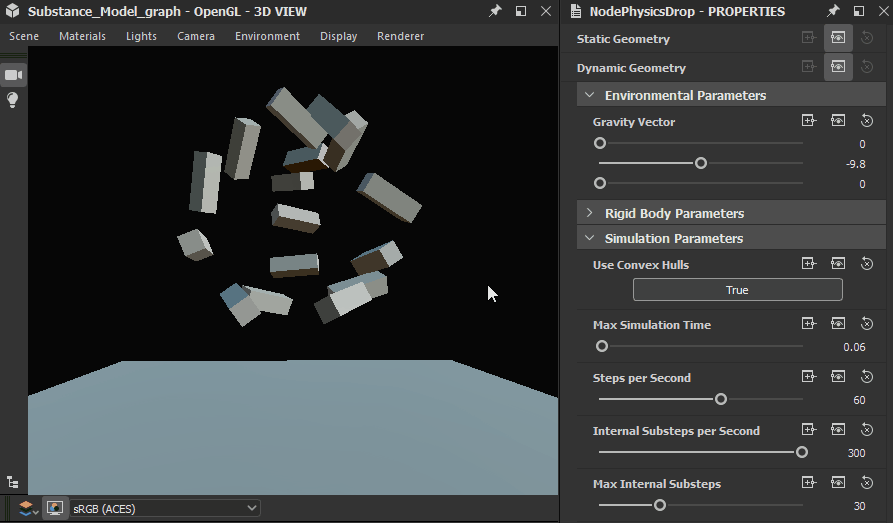Physics drop


In: Substance model graphs > Scene management
Description
The Physics drop node runs a physics simulation on the elements of two input scenes: dynamic (the dropped elements) and static (the obstacles for the dropped elements), involving a gravity force.
The simulation inflicts the gravity acceleration force to the dynamic elements, which may collide with static elements or other dynamic elements and receive restitution (i.e. rebound), friction and damping force which impact their linear and angular velocities.
The precision and span of the simulation can be tweaked, as well as the contribution of each force.
Parameters
- Static geometry Scene
The input scene holding the static elements in the simulation – i.e. the elements on which other elements should be dropped, - Dynamic geometry Scene
The input scene holding the dynamic elements in the simulation – i.e. the elements which should be dropped. - Environmental parameters
- Gravity vector Vector3
The acceleration vector acting on the dynamic elements of the simulation. Acceleration on the X, Y and Z axis is mapped respectively to the X, Y and Z components of a vector3.
- Gravity vector Vector3
- Rigid body parameters
- Friction Float
The amount of friction applied on the dynamic elements of the simulation as they touch other elements. - Restitution Float
The amount of energy given back to dynamic elements of the simulation as they collide with other elements – i.e. rebound force, expressed as a multiplier of the original force from 0 (no force is given back) to 1 (full force is given back). - Linear damping Float
The amount of deceleration applied on the linear velocity – i.e. translation – of dynamic elements of the simulation. - Angular damping Float
The amount of deceleration applied on the angular velocity – i.e. rotation – of dynamic elements of the simulation. - Linear sleeping velocity threshold Float
The linear velocity – i.e. translation – below which a moving dynamic element of the simulation is set to sleep – i.e. deactivated.
Note: Sleeping means the simulation system considers the element is not moving, thus will not update it until it receives a force from an external source. - Angular sleeping velocity threshold Float
The angular velocity – i.e. rotation – below which a moving dynamic element of the simulation is set to sleep – i.e. deactivated.
Note: Sleeping means the simulation system considers the element is not moving , thus will not update it until it receives a force from an external source. - Deactivation time Float
The amount of time an object needs to be unmoving to be automatically set to sleep – i.e. deactivated.
Note: Sleeping means the simulation system considers the element is not moving , thus will not update it until it receives a force from an external source.
- Friction Float
- Simulation parameters
- Use convex hulls Boolean
Enable more accurate collision detection by using convex hulls instead of Axis-aligned bounding boxes (AABB). The convex hull of a shape or volume is the smallest shape which can include it with the lowest amount of faces – think of a rubber band or a tightly fit plastic wrap. - Max simulation time Float
The maximum duration of the simulation in seconds. This parameter lets you stop the simulation earlier or let it play out further. - Steps per second Integer
The number of simulation steps which can be calculated during a second of simulation time. - Internal substeps per second Integer
The number of substeps the simulation can calculate during a second of simulation time. Substeps are subdivisions of individual simulation steps, are faster to run than steps of the entire simulation, and can help catch missed collisions which may have occurred between simulation steps.
Note: The actual substeps count is a combination of this parameter and the Max Internal Substeps value. For instance, for 10 steps and 200 substeps per second, 20 substeps could be run per step which are then compared against the Max Internal Substeps count and clamped accordingly. - Max internal substeps Integer
The maximum number of substeps which can be run per simulation step.
Note: To know more about the actual number of substeps run in a simulation, see the note in the Internal Substeps per Second parameter description. - Collision margin Float
Adds a distance margin from the surface of elements of the simulation, to detect collision by proximity in addition to contact. - Use quantized AABB compression Boolean
Use a compression algorithm to simplify collision detection between Axis-aligned bounding boxes (AABB) . Improves performance and memory usage at the cost of accuracy since the quantization step involves mapping the vertex coordinates to a limited set of values with of predefined precision, which is a lossy operation.
- Use convex hulls Boolean
- Output parameters
- Emit collision geometry Boolean
Description coming soon...
- Emit collision geometry Boolean
Example Images



